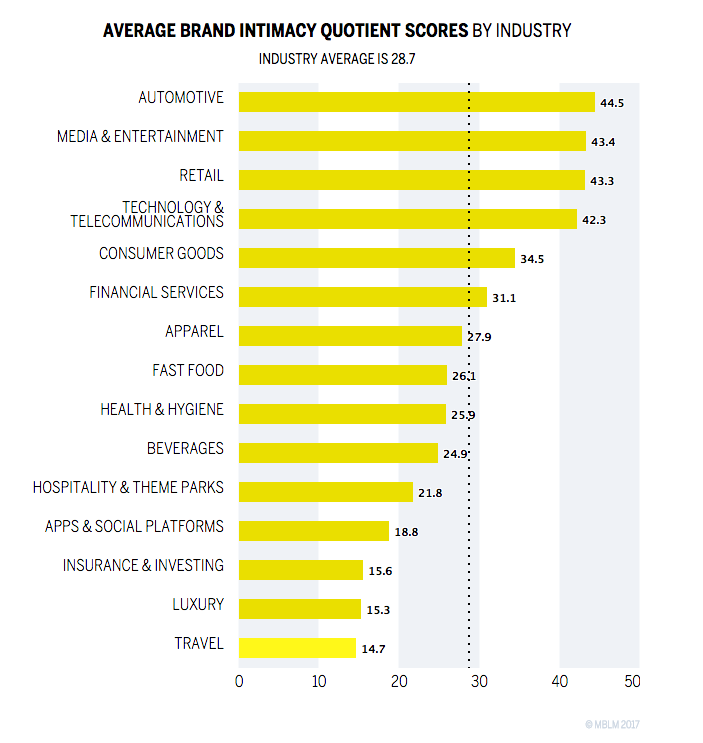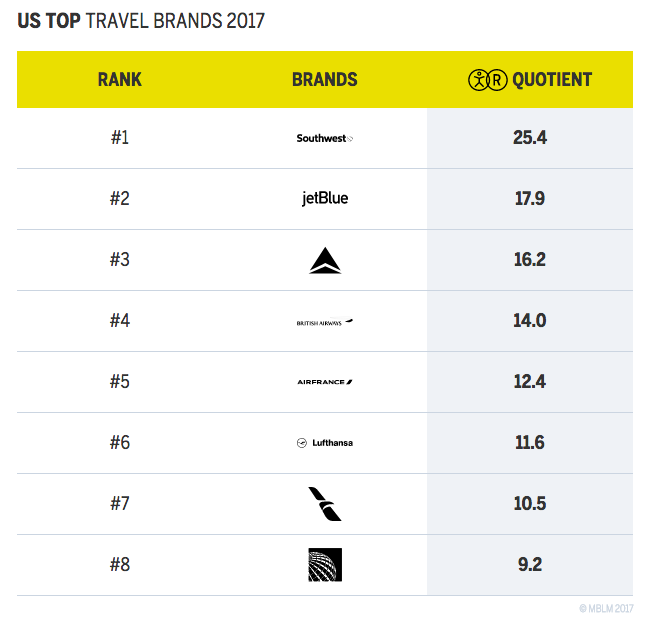Airlines are often associated with the worst aspects of the travel experience—expensive tickets, uncomfortable seats, unsavory food, long waits, cancelations, lost luggage and hidden fees. Brand intimacy agency MBLM recently revealed the travel industry has ranked last in its Brand Intimacy 2017 Report for the second year.
An industry that allows people to travel the world safely with relative ease has become defined by a collection of inconveniences and frustrations. In the U.S., airline brands have been driven out of the good graces of the consumer, creating the opposite of brand intimacy—brand indifference. The industry has below-average scores for five out of the six archetypes (patterns that identify the character and nature of brand relationships), and below-average percentages of consumers in each of the three stages of brand intimacy.

“While airlines have faced many challenges and lately been mired in public relations catastrophes, they continue to strive to improve their offerings to attract customers and drive performance,” said Claude Salzberger, president at MBLM, in a news release. “These efforts are crucial—however, airlines need to focus more on endearing consumers to their brands and building strong, lasting bonds. Southwest is leading the way by being unique, authentic and more customer centric.”
Not all travel brands are suffering from this reputational relapse: The report, the largest study of brands based on emotions, found that challenger brand Southwest ranked first in the industry, followed by JetBlue and Delta. In the U.S., the remaining travel brands that are part of the top eight are: British Airways, Air France, Lufthansa, American Airlines and United Airlines.

Consumers are willing to pay a 10 percent price premium for Southwest and JetBlue than they are for other travel brand, with an impressive 44.5 percent willing to pay this premium for Southwest.
Southwest—with a Brand Intimacy Quotient of 25.4, compared to the industry average of 14.7—has done a better job at delivering intimacy through an authentic brand that gives consumers the feeling that the airline is “on their side.” At every level of its brand, Southwest outpaces the competition, distinguishing itself as more transparent, human and emotivate.
Since its inception in 1971, Southwest has stood on the side of the customer and kept prices down—its essence—and had a customer-driven service culture. The “airline with a heart” has been consistently profitable and grown into the largest airline operator in the U.S. Southwest’s story is one of a small, local airline with a different approach to flying that travelers really appreciate. This story still connects to something compelling and authentic and defines the brand unlike the rest of the industry. And its flying experience makes the Southwest brand ring true. It distinguishes itself with its warm, friendly staff and unique boarding experience where passengers choose their own seats.
JetBlue, which is also authentically perceived, has a story that is fiercely committed to going above and beyond for its customers, whether it is adding extra legroom, having extra amenities or simply treating passengers with a higher standard of respect. Its Customer Bill of Rights states the airline’s commitment to providing the most pleasant experience possible and clearly listing its policies. JetBlue sets itself apart in experience as well by adding perks to its flying experience. From in-slight entertainment to added legroom, it tries to make the “experience as simple and pleasant as possible.”
“Brand intimacy” is defined as a new paradigm that leverages and strengthens the emotional bonds between a person and a brand. According to the 2017 report, top ranked intimate brands continued to outperform the S&P and Fortune 500 indices in revenue and profit over the past 10 years.
This year’s report contains the most comprehensive rankings of brands based on emotion, analyzing the responses of 6,000 consumers and 54,000 brand evaluations across 15 industries in the U.S., Mexico and UAE. MBLM’s reports and interactive Brand Ranking Tool showcase the performance of almost 400 brands, revealing the characteristics and intensity of the consumer bonds. Download the full report here.
During 2016, Praxis Research Partners conducted an online quantitative survey among 6,000 consumers in the United States (3,000), Mexico (2,000), and the United Arab Emirates (1,000). Participants were respondents who were screened for age (i.e. 18 to 64 years of age) and annual household income ($35,000 or more) in the U.S. and socioeconomic levels in Mexico and the UAE (A, B, and C socioeconomic levels). Quotas were established to ensure that the sample mirrored census data for age, gender, income/socioeconomic level, and region.



